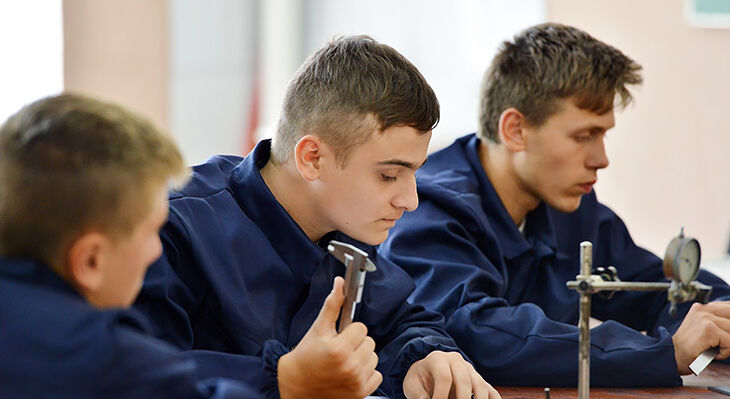Moldova: Structural reforms for a strong VET system
Moldova is well ahead of its neighbours in terms of VET. It is the only country in South Eastern Europe that offers a dual VET system with clear-cut shared roles embedded in an institutional architecture. For this reason, it can play a pioneering role when introducing dual VET.

In Moldova, a new trend has emerged, most probably fueled by the Eastern Partnership initiative of the European Union: as the economy of Moldova develops, with significant involvement of foreign investors, so increases the pressure on the educational system to deliver qualified, yet flexible staff. Naturally, therefore, the interest for dual VET, which offers a quick and sustainable solution, is increasing together with the increase in employability and salary scale of the successful students. Germany supports Moldova in its declared efforts to achieve a better VET system.
GIZ on behalf of the Ministry of Economic Cooperation and Development (BMZ) aims at strengthening the dual VET component for sustainable economic development. A new project provides support to the government of Moldova in the ambitious process of development and consolidation of a dual VET system. The project “Support to Vocational Education and Training in the Field of Green Economy” is designed to be implemented in the period from 2018 to 2021. Its goal is to harness the existing potential of dual VET contribution to ecological, economic and social development, all very much in line with Moldova’s environmental and climate relevant strategies, as well as the Agenda 2030.
In the period from 2015 to 2018, the German cooperation supported the Moldovan Government to embark on the VET improvement, focused on the increase of responsiveness of the education system to the needs of the real economy.
The essence of the change consists in a wider involvement of bodies representing the economic sector in shaping and implementing dual VET process. Although at its beginning, the reform process already produced clear results: on the legislative front and based on the provisions of the Education Code mentioned below, the Government approved the Regulation on dual VET (January 2018), that establishes clear roles for the three institutional actors: public VET providers, companies and the Chamber of Commerce and Industry. As such, today Moldova is the only country in South-Eastern Europe that offers a dual VET system with such clear-cut shared roles (schools, companies, chamber). The stability of such an institutional architecture entails a significant competitive advantage to attract employment-relevant and long-term investments.
The practical consequences followed the legislative actions: in the 2018 and 2019 academic year, approx. 70 companies entered in dual cooperation with 30 VET providers, with over 1100 new apprentices in 15 economic sectors, ranging from automotive supply, metal processing, agricultural machinery assembly to electrical engineering, forestry or medicine. As a significant step forward, the Chamber of Commerce and Industry, according to its mandate to support and monitor the dual VET process, has trained and certified 79 in-company trainers, thus participating in the long-term sustainability of the dual VET system.

At the specific demand of the private sector, the project supported the development of 11 new, needs-oriented, dual VET training programs. The private sector was part of the team that elaborated those programs, together with the involvement in 15 occupational profiles specifically drawn up to further define knowledge, skills and competences of the future graduates, in accordance to labor market demand. The elaboration of outcomes-based curricula, alongside with corresponding in-company training plans, as well as the development of teaching and learning materials was and will continue to be within the scope of the dual VET projects, past and current.
Beyond the institutional efforts in improving the VET system, the projects devote significant efforts into changing the perception of professional training in general. Indeed, the professional educational pathway suffers in terms of reputation and therefore is not yet highly regarded by learners, their families and the society at large. With the clear goal to increase the reputation and social recognition of this educational pathway, the project continues to follow through with the awareness raising campaign. A complete comprehensive, multi-level communication plan, designed to reach out to a larger number of young people and their families, enterprises, as well as schools was put into place. The strong ownership by the successive ministers of education helped the communication campaign to make familiar with the opportunities and advantages of dual VET an increased number of students. A direct consequence for the academic year 2018 and 2019, is a record number of 1251 of apprenticeship places within dual VET programs, and a total of 1500 apprentices trained in ca. 40 trades and specialties.
As expected, zones of improvement still remain, with ongoing efforts at the level of the Ministry and the social partners to solve such inevitable issues. Possibly the most representative such situation is the fact that due to the initial success of the project, the demands of the companies exceed for the first time the capacities of the public schools to attract dual VET students. This issue that was diagnosed to be the result of a temporary lack of dual VET coordination at Governmental level and is currently under scrutiny for finding an optimal solution.
Meanwhile, from 2019 to 2021, the follow-on GIZ project that was mentioned above will address a challenge that could not be more topical: VET in the field of Green Economy.
Why implementing Dual VET in Moldova?
The German model of demand-driven dual VET was first mentioned in an official document in Moldova in the Code of Education of 2014. It was introduced as a loosely regulated educational possibility, with the hope that it will become a factor of growth of the foreign direct investments, youth employability, as well as an opening towards new type of jobs, with a focus on eco-friendly economic activities, previously unavailable in Moldova.
Practical implementation of dual VET in Moldova presented, a priori, several worth-to-notice features. Firstly, it is noticeable that the post-soviet society of Moldova has undergone several major changes in a short period of time, requiring significant adaptation processes. VET was clearly one of the strongly impacted fields, essentially as a consequence of drastic changes in the structure of the economy: the rigid, centralized and multi-annual planned economy evolves towards a market-based economy.
Secondly, in the old Soviet system, at the end of a study-cycle, students automatically received a job, without the need of particular efforts of the schools. Therefore, the schools entered the XXI century without the reflex of a close cooperation with the real economy, a large part of which became private.
Thirdly, since the trust level between the private companies and governmental actions remained low, companies hesitated in allocating resources in their interaction with the public system, the more so long-term planning of many companies was not a general feature of Moldovan economy.
Finally, the privileged relation with the EU, especially Romania, materialized by the fact that a very large part of Moldovan citizens hold Romanian citizenship that allows them to easily migrate and work in EU countries, creates additional pressure on the companies that potentially involve in VET, since at the end of the studies apprentices are likely to not remain and work in the country.